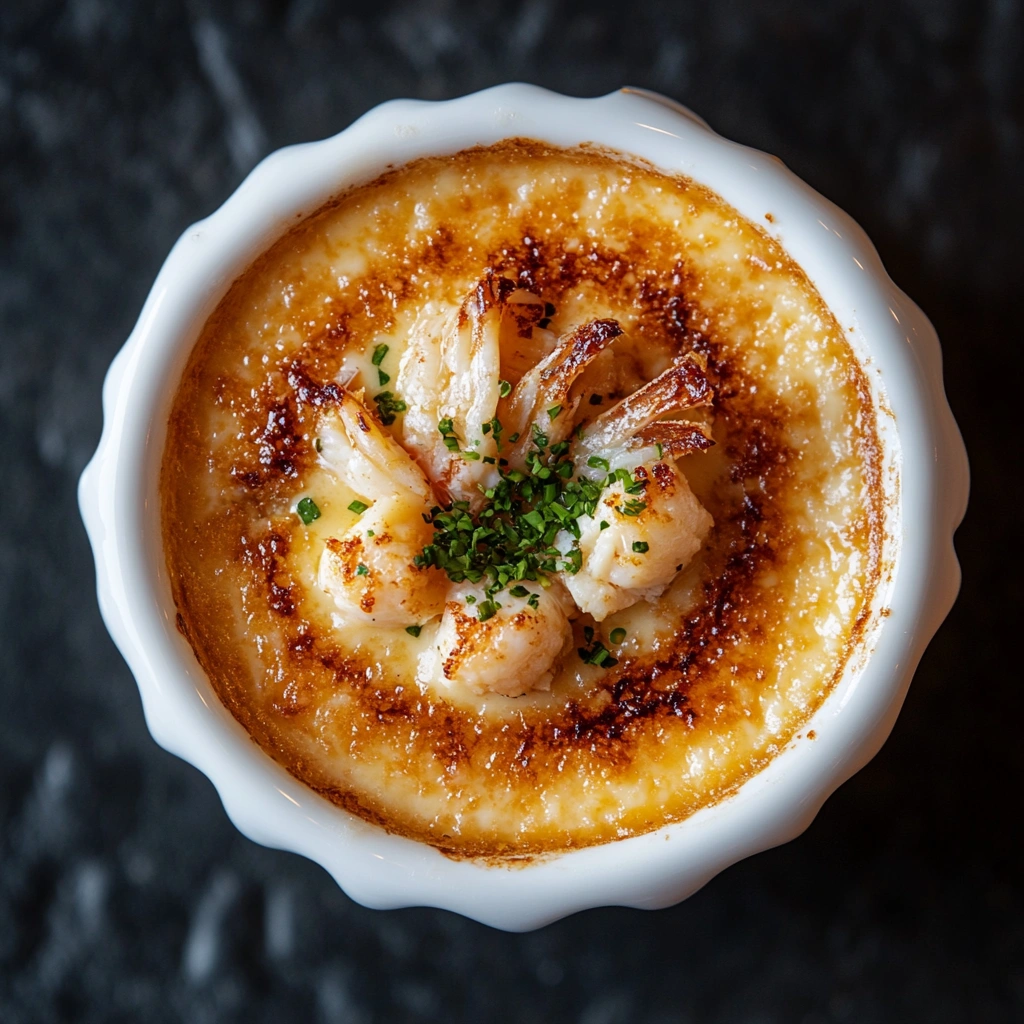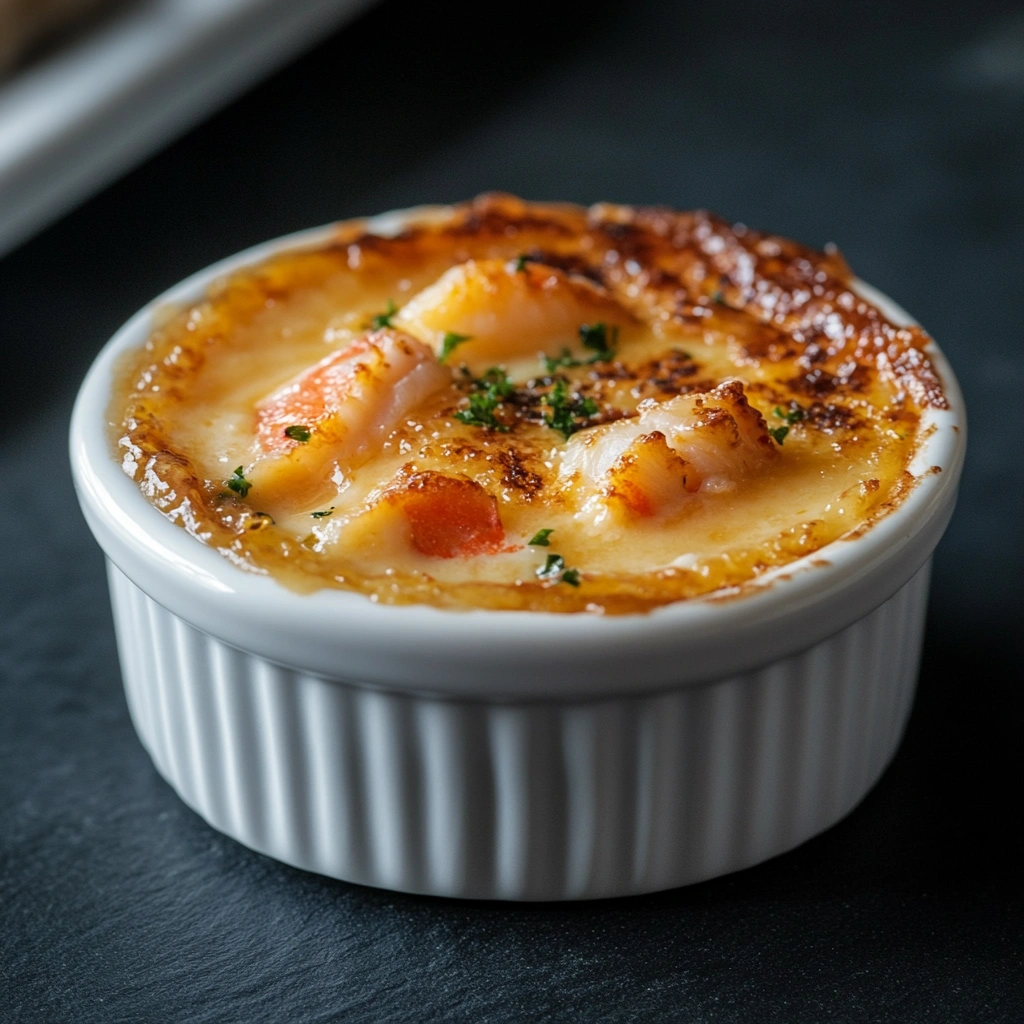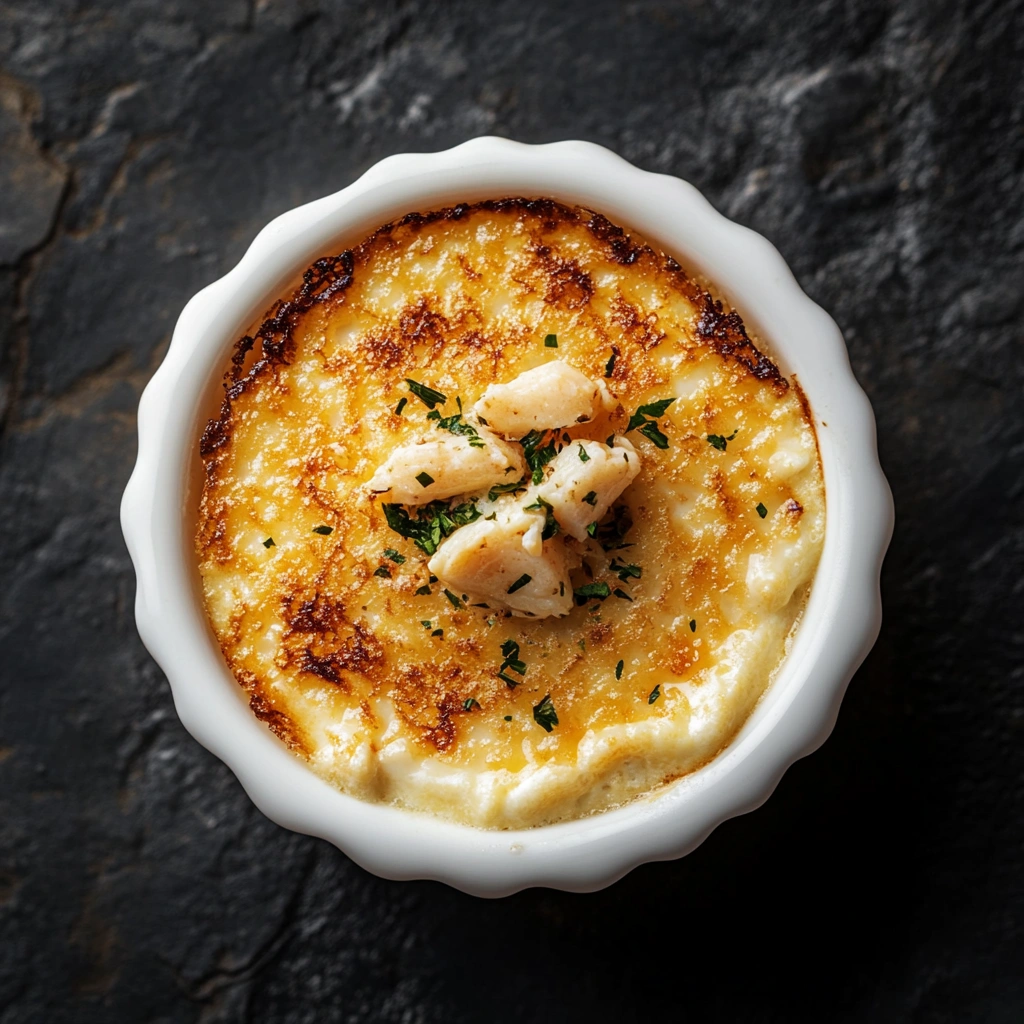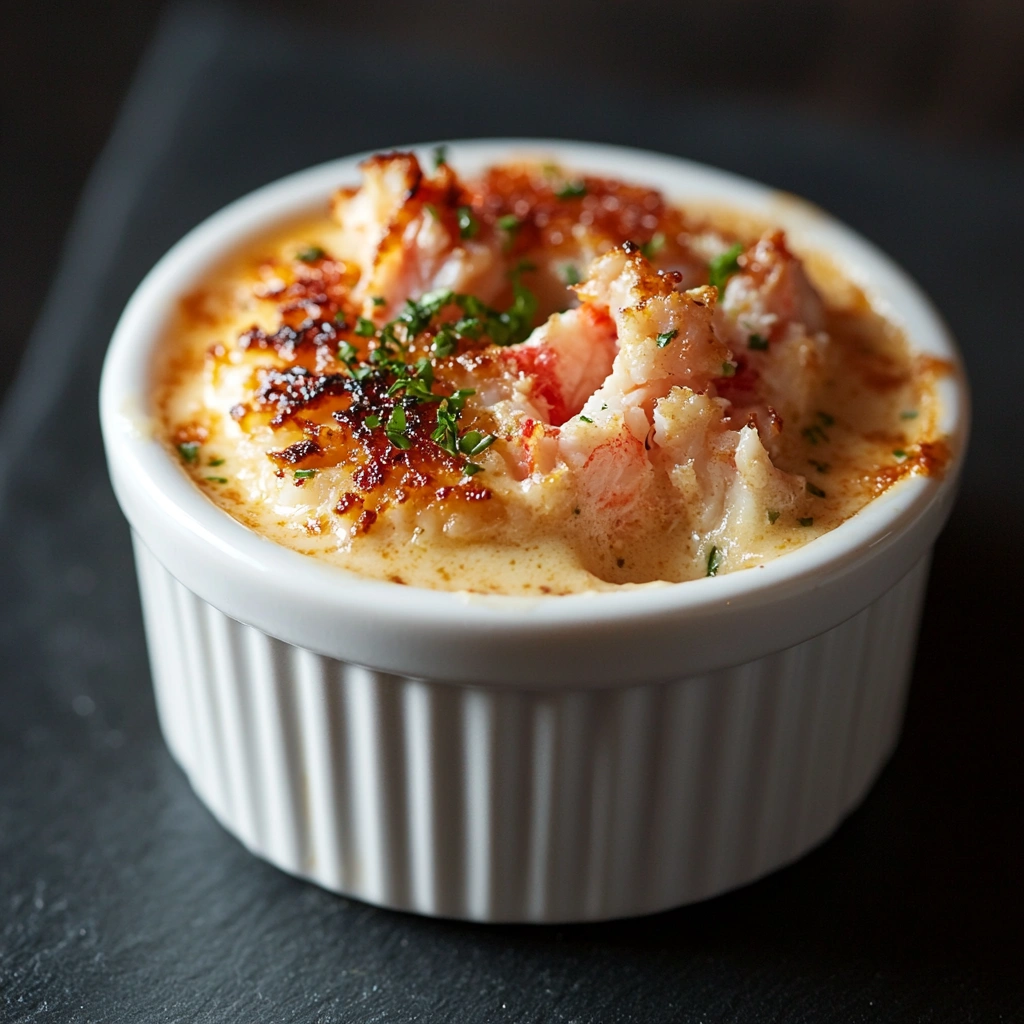Crab Brulee is an innovative dish that blends the richness of crab meat with the velvety texture of a classic crème brûlée custard. This dish merges French culinary tradition with modern seafood influences, creating a savory brûlée that challenges traditional dessert expectations. The contrast of sweet caramelized sugar against the delicate umami of crab makes Crab Brulee a dish that is increasingly appearing on fine dining menus and gaining recognition among food enthusiasts.
This guide explores the origins of Crab Brulee, the best types of crab meat to use, and how to select the right ingredients for a perfectly balanced dish. For those interested in another unique brûlée variation, check out Crème Brûlée vs. Custard to understand the fundamentals behind brûlée-style dishes.
Introduction: The Fusion of Land and Sea
What is Crab Brulee?
Crab Brulee is a savory twist on the classic crème brûlée, replacing the usual vanilla custard with a silky, seafood-infused base. The custard incorporates lump crab meat, cream, eggs, and aromatic seasonings, topped with a caramelized sugar crust that adds a slightly sweet contrast.
The appeal of Crab Brulee lies in its textural contrast—the soft, creamy custard against the crisp, caramelized topping. The balance of sweet and savory flavors makes this dish a standout in modern fusion cuisine.
How Crab Brulee Combines Savory Seafood with a Classic Dessert Technique
Traditional crème brûlée is defined by its smooth custard base and crisp caramelized sugar topping. Crab Brulee follows the same technique but replaces the sweet vanilla flavors with rich, briny seafood notes. Key elements include:
- Custard Base: A mixture of egg yolks, cream, and seasonings infused with crab meat.
- Aromatic Enhancements: Herbs, citrus zest, and mild spices enhance the seafood’s depth.
- Signature Sugar Crust: A thin layer of caramelized sugar creates a contrast between sweet and umami flavors.
Why Crab Brulee is Gaining Popularity in Fine Dining
Crab Brulee is increasingly found on the menus of high-end restaurants due to its elegant presentation and complex flavor profile. Factors contributing to its popularity include:
- Growing demand for savory brûlées in contemporary cuisine.
- The appeal of seafood-infused custards in gourmet settings.
- Versatility as both an appetizer and a sophisticated main course component.
For more seafood-inspired gourmet recipes, explore Ultimate Branzino Recipe Guide.
The Origins and Inspiration Behind Crab Brulee
The Influence of Classic Crème Brûlée on Crab Brulee
The foundation of Crab Brulee is inspired by classic crème brûlée, a dessert dating back to 17th-century France. The traditional brûlée technique—where a custard base is topped with caramelized sugar—was adapted by modern chefs to explore savory applications.
Key historical influences include:
- French Cuisine: Where seafood custards, such as lobster bisque and seafood soufflés, are common.
- Molecular Gastronomy: The experimentation of textures and flavors in fine dining.
- Fusion Cuisine: The integration of savory seafood with classic French dessert techniques.
How Chefs Began Experimenting with Savory Brûlées
As chefs sought to expand the applications of brûlée-style dishes, they explored savory ingredients like:
- Foie gras brûlée, blending creamy duck liver with caramelized sugar.
- Cheese brûlée, using aged cheeses for depth.
- Seafood brûlée, incorporating crab, lobster, and shrimp.
The Role of Seafood in French and Modern Fusion Cuisine
Seafood custards are not a new concept in French cuisine. Classic dishes like seafood bisques and mousselines have long been part of haute cuisine. However, Crab Brulee modernizes this tradition by combining textural contrast with bold flavors.
For another seafood-based gourmet dish, visit How to Cook and Eat Branzino.
Choosing the Right Crab for Brulee
Best Crab Varieties for Crab Brulee
The type of crab used in Crab Brulee significantly impacts its flavor, texture, and richness. Some of the best crab varieties include:
- Dungeness Crab: Sweet, tender meat with a delicate texture.
- Blue Crab: Milder in flavor, often used for its soft, flaky meat.
- King Crab: Rich and firm, best for a bold seafood presence.
Fresh vs. Canned Crab Meat: Pros and Cons
Using fresh crab meat is ideal for the best texture and flavor, but canned crab meat can be a convenient alternative.
Fresh Crab Meat
Superior texture and natural sweetness.
Best for high-end dining applications.
Requires careful cleaning and preparation.
Canned Crab Meat
More affordable and convenient.
Easier to store and use.
May lack the depth of flavor found in fresh crab.
For those interested in seafood preparation techniques, check out Sinigang Recipe, a dish that balances seafood with bold flavors.
How to Properly Prepare and Handle Crab Meat
Proper preparation is essential to maintaining the integrity of the crab meat in Crab Brulee.
- Pick through for shell fragments: Even processed crab may contain small pieces of shell.
- Drain excess liquid: Prevents a watery texture in the custard.
- Use lump crab meat: Provides the best flavor and presentation.
Essential Ingredients for the Perfect Crab Brulee
The Role of Cream and Eggs in Achieving the Right Consistency
The secret to Crab Brulee is a well-balanced custard, achieved through the right ratio of cream and egg yolks.
- Heavy cream provides a rich and velvety texture.
- Egg yolks give structure and prevent separation.
- A small amount of milk can lighten the texture if desired.
Balancing Flavors: Crab, Aromatics, and Seasonings
The seasoning blend is key to bringing out the natural sweetness of the crab while maintaining a savory depth.
- Shallots and Garlic: Provide a mild aromatic base.
- Lemon Zest: Brightens the seafood flavor.
- Cayenne or Paprika: Adds subtle heat.
- White Pepper and Salt: Enhance umami without overpowering the dish.
Choosing the Right Sugar or Alternative Crust
The caramelized topping in Crab Brulee can be traditional sugar or an alternative:
- Superfine sugar creates a delicate, crisp crust.
- Brown sugar adds depth but caramelizes quickly.
- Parmesan cheese offers a savory, umami-rich crust as an alternative.
For more unique flavor pairings, explore Churro Cheesecake Recipe.

The Secret to Achieving a Perfectly Smooth Custard
Why Slow Cooking is Key to a Creamy Texture
A smooth custard is the foundation of Crab Brulee, and slow, controlled cooking is essential to preventing curdling. Rapid heat can cause the eggs to scramble, resulting in a grainy texture instead of the intended silky consistency.
To achieve a perfectly smooth Crab Brulee custard, follow these guidelines:
- Cook at low temperatures (300°F-325°F) to prevent overcooking.
- Stir gently when mixing eggs with cream to avoid incorporating too much air.
- Use fine-mesh strainers to remove any lumps before baking.
How to Prevent Curdling or Separation
Custard separation is often due to incorrect temperature control or overcooking. Avoid this by:
- Tempering the egg yolks by gradually adding warm cream instead of combining all at once.
- Using fresh eggs, as older eggs have a weaker protein structure.
- Checking for doneness by using the wobble test—custard should jiggle slightly but not be runny.
For another dish where texture is key, check out Easy Yellow Rice Recipe.
Water Bath (Bain-Marie) Technique for Even Cooking
A bain-marie (water bath) is essential for evenly distributing heat and preventing the custard from cooking too quickly.
To prepare a proper water bath:
- Place ramekins in a deep baking dish.
- Pour hot water halfway up the sides of the ramekins.
- Bake at a low, steady temperature for even cooking.
This method creates a gentle cooking environment, preventing the outer edges from overcooking before the center is set.
Caramelization: Creating the Perfect Brûlée Crust
Should You Use Sugar or a Savory Alternative?
Traditional crème brûlée features a caramelized sugar crust, but Crab Brulee allows for both sweet and savory toppings.
Options include:
- Classic Sugar Crust: A thin layer of superfine sugar, caramelized for a crisp contrast.
- Parmesan or Gruyère Crust: A savory brûlée option that enhances the umami of the crab.
- Breadcrumb Topping: Adds a slight crunch without overpowering the custard.
For more dishes with unique crusts, explore Churro Cheesecake Recipe.
How to Torch the Topping for a Crisp Finish
To achieve the signature brûlée crust:
- Sprinkle a thin, even layer of sugar or cheese on top.
- Use a kitchen torch to caramelize until golden brown.
- Allow to set for 30 seconds before serving to harden properly.
Alternative Methods: Broiling vs. Using a Torch
If a kitchen torch is unavailable, the broiler method can be used.
- Set the oven broiler to high.
- Place ramekins on the top rack and watch carefully.
- Rotate as needed for even caramelization.
Broiling works, but it requires close monitoring to prevent burning.

Flavor Enhancements and Pairings
Herbs and Spices That Complement Crab Brulee
Enhancing Crab Brulee’s depth of flavor involves carefully selected herbs and spices. The following ingredients pair well with crab’s natural sweetness:
- Tarragon: Adds a mild anise-like flavor.
- Chives: Introduces a delicate onion aroma.
- Saffron: Elevates the richness with floral notes.
Adding Depth with Wine or Brandy-Infused Custard
A splash of wine or brandy can bring complexity to Crab Brulee’s custard.
- Sherry or Dry White Wine: Enhances seafood flavors without overpowering.
- Brandy or Cognac: Adds a bold, refined character.
To see how alcohol is used in another seafood dish, check out Sinigang Recipe.
Creative Ingredient Twists
For a gourmet twist, consider:
- Truffle Oil: Adds an earthy depth.
- Caviar Garnish: Provides a salty contrast to the sweetness.
- Citrus Zest: Brightens the dish with a fresh note.
Serving and Presentation Tips
Choosing the Best Ramekins for Individual Portions
The right ramekins ensure the proper custard-to-crust ratio.
- Shallow Ramekins (4-5 inches wide): Ideal for an even custard layer and consistent caramelization.
- Deep Ramekins (2-3 inches tall): Best for a richer, thicker custard, though caramelization may be uneven.
For more insights on plating, explore Peach Crumble Recipe.
Garnishing Ideas for an Elegant Look
A well-presented Crab Brulee enhances the dining experience. Consider:
- Microgreens or Edible Flowers for a refined appearance.
- Crushed Sea Salt to contrast with the sweet brûlée topping.
- Lemon Wedges for a bright citrus accent.
Ideal Serving Temperature for Maximum Flavor
- Slightly chilled but not ice-cold for the best texture.
- Allow to sit for 10-15 minutes before serving to let flavors develop.
Pairing Crab Brulee with Drinks and Side Dishes
Best Wines to Complement Crab Brulee
Pairing Crab Brulee with the right wine enhances its complexity. Recommended options include:
- Chardonnay: Buttery and full-bodied to match the richness.
- Champagne: A crisp, effervescent contrast to the creamy custard.
Bread and Cracker Pairings for Texture Contrast
A light, crispy element complements the softness of Crab Brulee.
- Toasted Baguette Slices: Offer a neutral, crunchy base.
- Herb Crackers: Infuse subtle seasoning without overpowering.
Side Dishes That Enhance the Experience
- Light Arugula Salad: A peppery contrast.
- Grilled Asparagus: Adds a smoky, fresh element.
For another seafood pairing idea, visit Ultimate Branzino Recipe Guide.

Common Mistakes and Troubleshooting
Even experienced chefs can run into challenges when making Crab Brulee. Below are some of the most frequent issues and how to prevent them.
Why Your Custard Might Turn Out Grainy and How to Fix It
A grainy custard results from overcooked eggs, causing them to scramble rather than blend smoothly. This happens when:
- The oven temperature is too high, cooking the custard too quickly.
- The custard is not stirred properly before baking.
- The water bath does not provide even heat distribution.
How to fix it:
- Bake at 300°F to 325°F using a water bath for gentle, even cooking.
- Always strain the custard before pouring it into ramekins to remove any egg solids.
- Avoid using high heat on the stovetop when tempering the eggs.
For another custard-based dish that requires precise temperature control, visit Crème Brûlée vs. Custard.
Preventing an Overly Fishy Taste
Crab is naturally briny, but an overly fishy taste can overwhelm the delicate balance of flavors in Crab Brulee. This usually happens when:
- The crab meat is not fresh or was stored improperly.
- The recipe lacks acidity, which balances the seafood’s natural intensity.
- The custard has too much salt, amplifying the briny flavor.
How to fix it:
- Use fresh lump crab meat whenever possible. If using canned crab, rinse and drain it well.
- Add a splash of lemon juice or white wine to lighten the seafood’s richness.
- Season carefully, as some crab meat is naturally salty.
For more seafood preparation tips, check out Sinigang Recipe, which also balances seafood flavors with acidity.
Achieving the Perfect Balance of Sweet and Savory
A well-made Crab Brulee should have harmony between sweetness, umami, and richness. Issues arise when:
- The sugar crust is too thick, overpowering the crab’s delicate flavor.
- The custard is too sweet or too salty, throwing off balance.
- The seasonings do not complement the crab, leading to an uneven taste.
How to fix it:
- Use a thin, even layer of sugar or a savory alternative like Parmesan.
- Taste-test the custard before baking, adjusting seasoning as needed.
- Experiment with subtle spices like white pepper, paprika, or nutmeg.
For another dish that balances sweet and savory elements, explore Peach Crumble Recipe.
Variations of Crab Brulee from Around the World
While Crab Brulee has roots in French culinary techniques, chefs worldwide have adapted it with regional flavors.
Asian-Inspired Versions with Miso or Soy
In Japan and China, miso paste or soy sauce is used to bring a savory depth to seafood dishes. Asian versions of Crab Brulee may include:
- White miso blended into the custard for umami richness.
- Soy sauce or fish sauce to enhance the crab’s natural brininess.
- Toasted sesame seeds or wasabi as a garnish for additional depth.
Mediterranean Influences with Saffron and Olive Oil
The Mediterranean approach to Crab Brulee leans on herbs and aromatic spices:
- Saffron-infused cream for a floral, golden custard.
- Olive oil drizzle instead of sugar for a savory crust.
- Fresh thyme or oregano to add an earthy note.
For another dish incorporating Mediterranean flavors, visit Ultimate Branzino Recipe Guide.
Southern U.S. Twists with Old Bay and Smoked Paprika
In Southern cuisine, crab is often paired with bold, smoky spices. A regional take on Crab Brulee could include:
- Old Bay seasoning for a classic Maryland-style flavor.
- Smoked paprika for a touch of spice and warmth.
- Cornbread crumbs instead of sugar for a crunchy topping.
For more Southern-inspired dishes, check out Tinis Mac and Cheese.
Final Thoughts: Mastering Crab Brulee in Your Own Kitchen
Why Practice Makes Perfect
Mastering Crab Brulee takes patience and attention to detail. Small adjustments in temperature, seasoning, and technique can drastically impact the final dish. Home cooks should:
- Take notes on what works and what doesn’t in each attempt.
- Experiment with different types of crab meat to find the best balance.
- Be mindful of custard texture and caramelization timing.
Encouraging Experimentation with Flavors and Textures
One of the greatest advantages of Crab Brulee is its versatility. The dish can be adapted to:
- Classic French elegance with a traditional sugar crust.
- Savory umami depth with aged cheese or miso.
- Regional spice blends to suit personal tastes.
For those interested in experimenting with unique textures and flavors, visit Sweet Potato Brownies Recipe Guide.
Try It and Make It Your Signature Dish
The best way to perfect Crab Brulee is by making it your own. Whether it’s through regional spices, alternative crusts, or unique ingredient pairings, this dish allows for creativity and innovation.
For additional tips on caramelization techniques, visit Allrecipes: The Science of Caramelization.


1 thought on “Crab Brulee Recipe: A Savory Twist on a Classic”